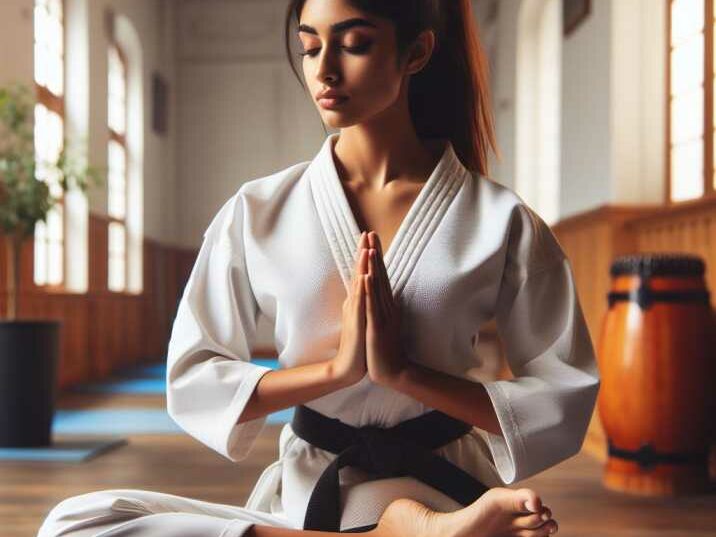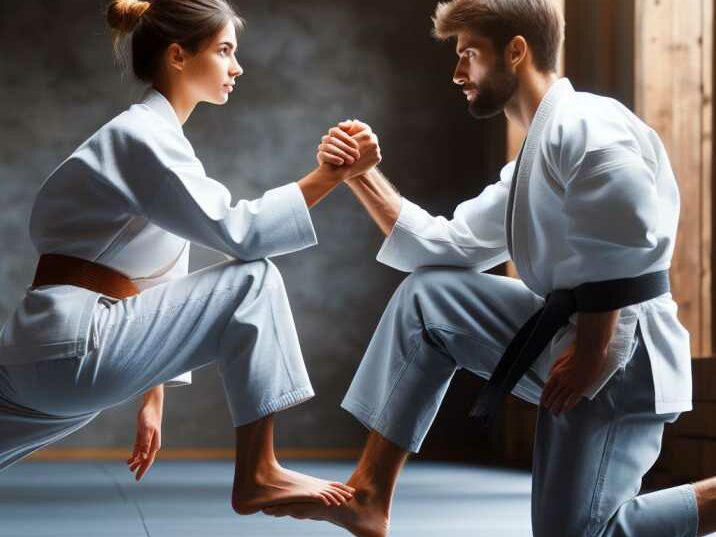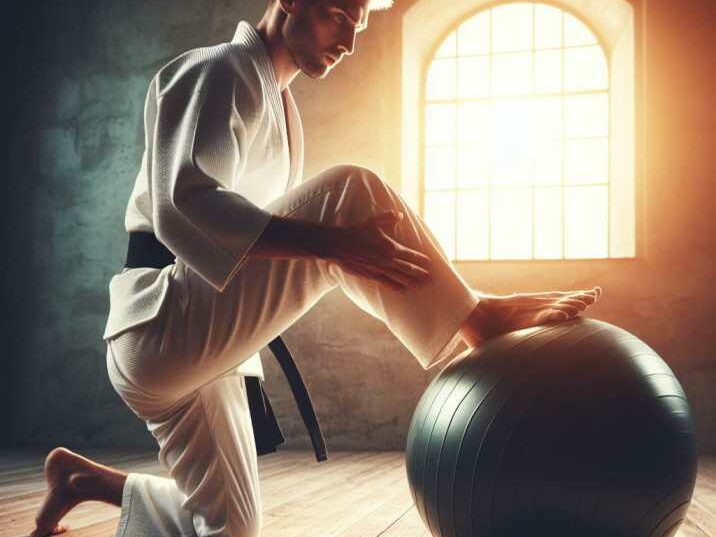Balancing Drills for Martial Artists
Table of Contents
Introduction:
Balancing is a foundational skill in martial arts that often separates the exceptional from the ordinary. Balancing Drills for Martial Artists, developing a strong sense of balance not only improves technique but also enhances overall performance. In this article, we will delve into the top 10 balancing drills tailored for the budding talents in the martial arts world.

The Tree Pose Challenge
Achieving balance requires a solid foundation. Begin with the classic yoga-inspired tree pose, focusing on grounding one foot while lifting the other to different heights. This drill enhances stability and concentration, vital for any martial artist.
Single-Leg Stability Board Exercises
Introduce an element of instability with a stability board. Execute various martial arts stances on the board, emphasizing control and precision. This drill mimics the unpredictable nature of real-world combat scenarios.
Dynamic Kicking Drills on BOSU Balls
Combine flexibility and balance by performing dynamic kicking drills on BOSU balls. These exercises challenge the martial artist to maintain equilibrium while executing powerful kicks, promoting agility and strength.
Targeted Balance Beam Training
Mimic the precision required in martial arts movements by walking, balancing, and even performing kicks on a narrow beam. This drill hones in on spatial awareness and control, preparing young martial artists for intricate techniques.
Partner-Based Balancing Exercises
Enhance cooperation and balance simultaneously with partner-based drills. From mirror exercises to tandem stances, these activities promote communication, trust, and shared stability, essential for martial arts duos.

Wobble Board Techniques
Integrate wobble boards into training to challenge stability further. Execute basic martial arts movements while balancing on the wobble board, progressively increasing difficulty. This drill improves core strength and reflexes.
Agility Ladder Balance Drills
Transform agility ladder drills into balance-enhancing exercises by incorporating lateral movements, hops, and jumps. This dynamic drill not only improves footwork but also sharpens the martial artist’s ability to maintain equilibrium during rapid transitions.
Swiss Ball Stability Training
Utilize Swiss balls for dynamic stability training. Performing kicks, punches, and stance transitions on the unstable surface of a Swiss ball strengthens the core muscles, promoting a more grounded martial artist.

Meditation and Balance Integration
Elevate mental focus and balance through meditation. Integrate mindfulness practices into martial arts training sessions, fostering a deep connection between the mind and body. This holistic approach enhances overall performance and concentration.Progressive Bouncing Drills
Implement controlled bouncing drills to simulate the unpredictable nature of combat. Gradually increase intensity and speed to challenge the martial artist’s adaptability and reflexes. This drill builds resilience and quick recovery in unpredictable situations.
Information-Based Table:
| Drill | Focus | Equipment | Benefits |
|---|---|---|---|
| Tree Pose Challenge | Grounding and concentration | None | Enhances stability |
| Single-Leg Stability Board Exercises | Control and precision | Stability board | Mimics real-world combat scenarios |
| Dynamic Kicking Drills on BOSU Balls | Agility and strength | BOSU ball | Combines flexibility and balance |
| Targeted Balance Beam Training | Spatial awareness and control | Balance beam | Prepares for intricate techniques |
| Partner-Based Balancing Exercises | Cooperation and trust | None | Enhances communication in martial arts duos |
| Wobble Board Techniques | Core strength and reflexes | Wobble board | Challenges stability further |
| Agility Ladder Balance Drills | Footwork and rapid transitions | Agility ladder | Improves balance during quick movements |
| Swiss Ball Stability Training | Core strength | Swiss ball | Strengthens the core for a more grounded martial artist |
| Meditation and Balance Integration | Mindfulness | None | Enhances mental focus and balance |
| Progressive Bouncing Drills | Adaptability and reflexes | None | Simulates unpredictable combat situations |
Importance of Balance in Martial Arts
Before delving into the specific drills, it’s crucial to understand why balance is a fundamental aspect of martial arts.
How to Safely Incorporate Balancing Drills into Training Sessions
To maximize the benefits of these Balancing Drills for Martial Artists, it’s essential to integrate them safely into regular training sessions.
Common Mistakes to Avoid in Balancing Drills
While practicing these Balancing Drills for Martial Artists, artists should be aware of common mistakes that can hinder progress.
Mastering the art of balance is not only about physical strength but also mental focus and coordination. These top 10 balancing drills for young martial artists are carefully curated to provide a comprehensive approach to skill development. From traditional stances to modern tools like stability boards and Swiss balls, each drill serves a unique purpose in enhancing the overall capabilities of young enthusiasts.
To read the full article and discover the detailed instructions for each balancing drill, continue scrolling. Whether you’re a martial arts instructor looking for innovative training methods or a young martial artist eager to level up your skills, these drills offer a diverse and engaging path to mastery.
Importance of Balance in Martial Arts
Balancing is more than just standing on one leg; it’s a critical skill that permeates every aspect of martial arts.
How to Safely Incorporate Balancing Drills into Training Sessions
While these balancing drills offer immense benefits, it’s essential to incorporate them safely into regular training sessions.
Common Mistakes to Avoid in Balancing Drills
Achieving balance is a journey filled with challenges, and avoiding common mistakes is key to making progress.
Conclusion:
In conclusion, balancing drills for martial artists is a journey that requires dedication, patience, and a strategic approach. These top 10 balancing drills for young martial artists provide a roadmap to elevate skills, from enhancing stability to promoting mental focus and cooperation. As young enthusiasts embark on this journey, they not only build a strong foundation for their martial arts journey but also cultivate qualities that extend beyond the dojo.
The importance of balancing drills for martial artists cannot be overstated. It is a foundational skill that influences every movement, kick, and punch. Through these carefully curated drills, young martial artists have the opportunity to hone their abilities in a diverse range of settings, from traditional stances to innovative tools like stability boards and Swiss balls.
In the grand tapestry of balancing drills for martial artists in martial arts, these balancing drills contribute not only to skill development but also to injury prevention. Improved balance leads to heightened body awareness, reducing the risk of injuries during training. Whether the goal is to excel in competitions, enhance self-defense capabilities, or simply enjoy the art form, the benefits of mastering balance are universal.
Balancing drills for martial artists are not just about physical strength; they also foster mental resilience and concentration. The incorporation of meditation and mindfulness practices underscores the holistic approach to martial arts training. By integrating these elements, practitioners not only become more adept at maintaining physical equilibrium but also develop a profound connection between mind and body.
As we wrap up this exploration of the top 10 balancing drills for martial artists, it’s essential to emphasize that progress is unique to each individual. Consistency and dedication are the keys to success on this journey. The drills presented here are not rigid rules but adaptable tools to be tailored to each practitioner’s needs and abilities.
In the realm of martial arts, the pursuit of balance is a dynamic and ever-evolving endeavor. Through these balancing drills for martial artists, young martial artists not only refine their techniques but also lay the groundwork for a resilient, focused, and disciplined approach to their art. So, as you step onto the training floor, remember that the quest for balance is not just about staying on your feet—it’s about rising to new heights in both skill and character.
FAQs:
- Q: How often should young martial artists practice these balancing drills? A: It’s recommended to incorporate these drills into regular training sessions, at least 2-3 times a week.
- Q: Are these balancing drills suitable for all martial arts disciplines? A: Yes, these drills are designed to benefit practitioners of various martial arts disciplines.
- Q: Can adults also benefit from these balancing drills? A: Absolutely, while these drills are tailored for young martial artists, adults can adapt them to their skill level for continued improvement.
- Q: Is it necessary to use specialized equipment for these drills? A: While some drills may require specific equipment, many can be performed with basic items found in a typical martial arts training environment.
- Q: How long does it take to see improvements in balance through these drills? A: The timeline varies for individuals, but consistent practice should yield noticeable improvements within a few weeks.
- Q: Are these drills suitable for beginners? A: Yes, beginners can start with modified versions of these drills and gradually progress as their skills develop.
- Q: Can these drills be practiced at home? A: Most of these drills can be adapted for home practice, with a focus on safety and appropriate space.
- Q: Do these drills help with injury prevention? A: Yes, improving balance contributes to overall body awareness and can help reduce the risk of injuries during martial arts training.
- Q: Are there any age restrictions for these balancing drills? A: While these drills are tailored for young martial artists, individuals of all ages can benefit from them with appropriate modifications.
- Q: Can these drills be incorporated into a group class setting? A: Absolutely, many of these drills are conducive to group training and can enhance the sense of camaraderie among martial arts practitioners.
- Q: Are there any prerequisites before starting these balancing drills? A: It’s advisable to consult with a martial arts instructor or fitness professional to ensure these drills align with individual fitness levels and goals.
- Q: How can parents support their young martial artists in practicing these drills at home? A: Parents can encourage a consistent practice routine, provide a safe training environment, and celebrate their child’s progress to keep them motivated.


